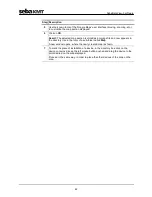
Connecting the logger and installing it on-site
33
6.2
Positioning the logger
The logger housing is protected against the ingress of dust and water and, thus,
especially qualified for the operation in pipeline shafts where it can be installed next to
the measuring point.
The logger can be installed in vertical and horizontal position or even upside-down and it
can also be hung up using, e.g., a cable tie.
During field installation the following instructions must be observed, in order to ensure
proper operation of the logger:
•
Make sure that all connections to sensors of other peripheral devices are
established in a professional manner and that the connection points are properly
insulated.
•
When you plug a connection cable in the respective socket, make sure you feel the
plug latch in. Only proper and positive locking connections provide protection
against ingress of water and ensure error-free data transfer.
•
Unused sockets must be sealed with the protective caps.
•
Do not bend the connection cables.
•
Care shall be taken to ensure that cables and their connections are not subjected to
tensile load.
•
Do not hang the logger on its connection cables.
•
Make sure the logger is switched on and programmed before you leave the site.
You have to observe the following instructions when positioning the GSM antenna:
•
The GSM antenna must be properly connected to the logger. Make sure that the
guide on the plug fits in the groove in the
GSM
socket
and that you feel the
plug latch in.
•
Be aware that thick walls and other barriers do affect the signal strength negatively.
•
If the logger is installed underground, e.g. in a pipeline shaft, the antenna should be
positioned as near as possible to the ground surface. The deeper the antenna is
positioned, the smaller is the chance of an adequate reception.
Check the GSM connectivity using the GSM test function of the SebaDataView-3
software (see page 67) right after the GSM antenna has been positioned.
If no connection can be established, a better position has to be found. If necessary, lead
the antenna out of the shaft and bury it a few centimetres under the ground surface.
General advices
Additional advices for
loggers with GSM
Summary of Contents for Sebalog D-3
Page 2: ...Consultation with SebaKMT 2...
Page 8: ...Terms of Warranty 8...
Page 26: ...Commissioning the logger 26...
Page 34: ...Connecting the logger and installing it on site 34...
Page 70: ...Programming the logger using the SebaDataView 3 software 70...
Page 78: ...Retrieving and evaluating data 78...
Page 88: ...Changing the battery 88...












































